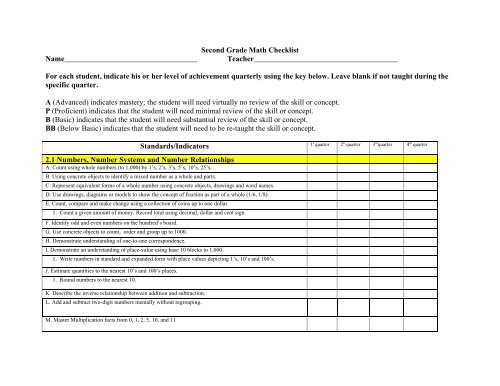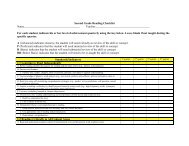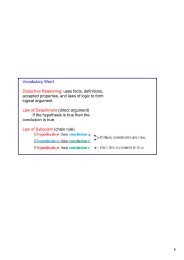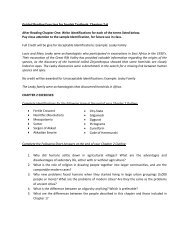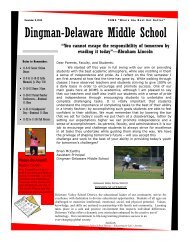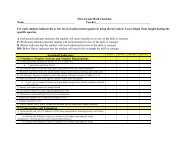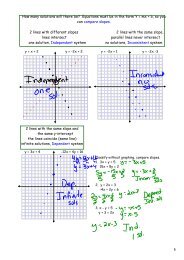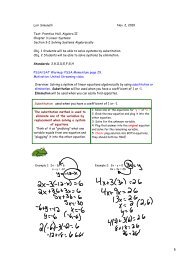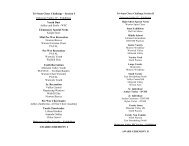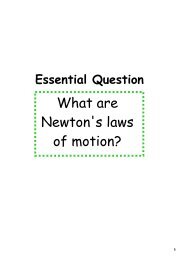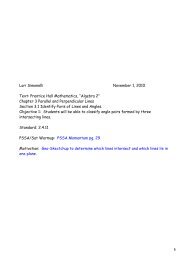Second Grade Math Checklist
Second Grade Math Checklist
Second Grade Math Checklist
Create successful ePaper yourself
Turn your PDF publications into a flip-book with our unique Google optimized e-Paper software.
Name___________________________________<br />
<strong>Second</strong> <strong>Grade</strong> <strong>Math</strong> <strong>Checklist</strong><br />
Teacher______________________________________<br />
For each student, indicate his or her level of achievement quarterly using the key below. Leave blank if not taught during the<br />
specific quarter.<br />
A (Advanced) indicates mastery; the student will need virtually no review of the skill or concept.<br />
P (Proficient) indicates that the student will need minimal review of the skill or concept.<br />
B (Basic) indicates that the student will need substantial review of the skill or concept.<br />
BB (Below Basic) indicates that the student will need to be re-taught the skill or concept.<br />
2.1 Numbers, Number Systems and Number Relationships<br />
A. Count using whole numbers (to 1,000) by 1’s, 2’s, 3’s, 5’s, 10’s, 25’s.<br />
B. Using concrete objects to identify a mixed number as a whole and parts.<br />
Standards/Indicators<br />
1 s quarter<br />
C. Represent equivalent forms of a whole number using concrete objects, drawings and word names.<br />
D. Use drawings, diagrams or models to show the concept of fraction as part of a whole (1/6, 1/8).<br />
E. Count, compare and make change using a collection of coins up to one dollar.<br />
1. Count a given amount of money. Record total using decimal, dollar and cent sign.<br />
F. Identify odd and even numbers on the hundred’s board.<br />
G. Use concrete objects to count, order and group up to 1000.<br />
H. Demonstrate understanding of one-to-one correspondence.<br />
I. Demonstrate an understanding of place-value using base 10 blocks to 1,000.<br />
1. Write numbers in standard and expanded form with place values depicting 1’s, 10’s and 100’s.<br />
2 n quarter 3 rd quarter 4 th quarter<br />
J. Estimate quantities to the nearest 10’s and 100’s places.<br />
1. Round numbers to the nearest 10.<br />
K. Describe the inverse relationship between addition and subtraction.<br />
L. Add and subtract two-digit numbers mentally without regrouping.<br />
M. Master Multiplication facts from 0, 1, 2, 5, 10, and 11
2.2 Computation and Estimation<br />
A. Apply addition and subtraction in everyday situations using concrete objects.<br />
B. Add 3 two-digit numbers with and without regrouping.<br />
1. Subtract two-digit numbers with and without renaming.<br />
C. Use repeated subtraction to demonstrate concept of multiplication<br />
D. Use repeated subtraction to demonstrate concept of division<br />
E. Use rounding to the nearest 10 to estimate answers.<br />
F. Use estimation to determine reasonableness of answers to addition and subtraction problems up to 100.<br />
G. Orally or in writing explain and describe the computation process in regrouping.<br />
2.3 Measurement and Estimation<br />
A. Compare measurable characteristics of different objects on the same dimensions (time, temperature, area,<br />
length, weight, perimeter).<br />
B. Measure and record the length, temperature and weight of familiar object to the nearest 1/2”, cm, 2°s, pound<br />
or kilogram<br />
C. Project the date(s) for the following week.<br />
D. Read and represent time to the nearest half-hour and in 5- minute intervals.<br />
E. Choose an appropriate unit of measurement.<br />
F. Use concrete objects to determine area and perimeter.<br />
G. Estimate and measure objects to the nearest inch or centimeter.<br />
H. Describe the different attributes of an object and how it can be measured (e.g., time, temperature, area, length,<br />
weight, and perimeter).<br />
2.4 <strong>Math</strong>ematical Reasoning and Connections<br />
A. Verify and explain predictions about quantity, size, and shape of objects.<br />
B. Use measurement in everyday situations to measure to the nearest pound, kilogram, 2°, 1/2”.<br />
2.5 <strong>Math</strong>ematical Problem Solving and Communication<br />
A. Select appropriate problem solving strategy (e.g., guess and check, working backwards) to solve problem.<br />
B. Describe what information is needed to solve a problem.<br />
C. Select and use an appropriate method, materials, and strategy to solve equations using mental math, paper and<br />
pencil, or concrete objects.<br />
2.6 Statistics and Data Analysis<br />
A. Gather, organize and display data using pictures, tallies, charts, bar graphs, and pictographs.<br />
B. Answer questions based on data from graphs.<br />
C. Use a chart or table that displays data over time and predict what conditions will change the data.<br />
D. State an opinion on whether a given statement is reasonable based on a comparison to data.
2.7 Probability and Predictions<br />
A. Predict the likelihood of an event and verify the prediction.<br />
B. Identify a spinner which is fair or unfair and explain why.<br />
C. Describe the possible results of an experiment.<br />
D. Collect and describe data using concepts of largest, smallest, most often, least often, and middle.<br />
2.8 Algebra and Functions<br />
A. Identify, describe, extend, and replicate patterns based on shape, size, color or sound.<br />
B. Solve number sentences using concrete objects and symbols (+, -, =).<br />
C. Use manipulatives to determine a missing addend in a number sentence.<br />
D. Demonstrate, solve, and describe story problems using addition or subtraction equations.<br />
E. Use concrete objects and other methods to solve addition or subtraction number sentences.<br />
F. Describe a repeating pattern and be able to extend it.<br />
G. Organize and compare data using bar graphs, tallies, and/or pictographs.<br />
H. Identify and interpret data shown in tables and charts.<br />
I. Use concrete objects to demonstrate function rule (e.g., input— output).<br />
J. Locate points on a simple grid.<br />
K. Identify the missing symbol (+, -, =, >,


